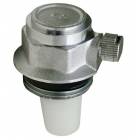Air vent valves to eliminate gases from a system
Thanks to air vent valves, we can limit the effects of gases that form in the plumbing

The formation of air or gas bubbles is one of the factors that reduce a circuit's performance and thermal exchange and most importantly produce noise inside it; these bubbles can be eliminated through the use of air vent valves. The formation of gas in a system has several causes, among which are the materials used, especially as sealants in the joints; however, the main cause is the quality of the water used normally as the circuit's primary fluid, and also as replenishing fluid.
Air vent valves ensure a proper removal of the gases created by the impurities dissolved in the fluid, which produce gaseous elements in the form of bubbles that move within the circuit due to the boiler heating up and the impurities' reaction to components of the system.
Pollutants in untreated water can generate for a long time gases such as oxygen, hydrogen, methane, carbon dioxide, and even nitrogen.
In order to enable automatic gas expulsion, the ideal placement of air vent valves is at the highest point of the circuit or at any other point where bubbles may form.
The body and the threaded portion of the lid of these air vent valves are brass CW617N; the valves can also be nickel plated, necessary in case of aggressive fluids or very hard water, which may cause brass dezincification.
Air vent valves ensure a proper removal of the gases created by the impurities dissolved in the fluid, which produce gaseous elements in the form of bubbles that move within the circuit due to the boiler heating up and the impurities' reaction to components of the system.
Pollutants in untreated water can generate for a long time gases such as oxygen, hydrogen, methane, carbon dioxide, and even nitrogen.
In order to enable automatic gas expulsion, the ideal placement of air vent valves is at the highest point of the circuit or at any other point where bubbles may form.
The body and the threaded portion of the lid of these air vent valves are brass CW617N; the valves can also be nickel plated, necessary in case of aggressive fluids or very hard water, which may cause brass dezincification.
25/06/2014
I contenuti di questo sito non hanno carattere di periodicità e non rappresentano 'prodotto editoriale'.








